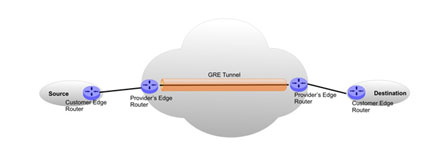General Routing Encapsulation (GRE) Protocol
Tunneling Protocols in Networks
Tunneling protocols generally encapsulate packets from a higher level or the same level, which is a contrast to standard protocol mechanism. Traditional protocols at lower level of OSI model undergo packet encapsulation from upper level. For example, a typical inclusion of packets is seen from Transport Layer being encapsulated by packets of Network Layer. Here the enclosure is from higher layer4 to next lower level layer3 protocol. A common protocol used for tunneling that most of the companies use in their networks is ‘Generic Routing Encapsulation’ (GRE), which is developed by Cisco.
General Routing Encapsulation (GRE) for Packet Encapsulation
For companies with VPNs, this protocol is applicable as it encloses IP packets for tunneling the traffic. It functions as a tunneling protocol covering a mixture of network layer protocols inside IP tunnels and is stateless with no relation between successive request-response pairs. This depicts that each tunnel endpoint do not retain any information about the state or availability of the remote tunnel. The consequence is - the local tunnel’s endpoint router is inept of obtaining the line protocol of General Routing Encapsulation (GRE) interface down and hence the remote end is inaccessible. Any static routes that point out that interface are removed from the routing table if line protocol for an interface is changed to down. This facilitates the installation of an alternate interface for policy-based routing.
Standard specification is RFC 1701 and IP-over-IP encapsulation is explained in RFC 1702 for its implementation. According to these standards, GRE packets enclose payload packets that hold details of source path and forwarded after encapsulated by the delivery protocol. In general, this protocol runs over IP-based networks. According to RFC 1918, this helps them to carry IP packets with private address using delivery packets with public IP addresses on the internet. The delivery and payload protocols are well suited whereas the payload addresses do not suit with those of the delivery network. Transportation of VPN traffic can be done with both IP/GRE tunnels even in networks that have not implemented MPLS. As a result, the outer label will be GRE/IP instead of the MPLS label.
Refer to Figure1 for GRE tunneling process.

MPLS-Over-GRE Tunneling: (Pic 2)
This feature provides a mechanism for tunneling Multiprotocol Label Switching (MPLS) packets over a non-MPLS network using GRE. This refers to the encapsulation of an MPLS packet in GRE. This allows the MPLS packets from one end of non-MPLS cloud to traverse through GRE tunnels and uncover by removing IP and GRE headers at the other end of Non-MPLS Cloud and then forwarded to its final destination as a MPLS packet. It is then processed and received as a MPLS packet, where the arriving label is the “top label” of unveiled packet. The two labels - outer and inner label of the capsulated packet function based on these intentions:
- The outer/top label comprises the delivery details to destination point
- Subsequent/inner label has further packet processing information.
The highlight in this mechanism is - the outer label can be substituted with encapsulation header of IP or GRE. This can be achieved without disrupting its prior functionality, for the reason that MPLS packet is encapsulated in GRE/IP headers. In this encapsulation mechanism, the encapsulating address in source address field of IP header is termed as “tunnel head”, whereas the address mentioned in destination address field is “tunnel tail”. This is termed as “Packet Encapsulation of MPLS-in-GRE or MPLS-in-IP”.
Benefits of MPLS over General Routing Encapsulation (GRE)
Implementing MPLS with General Routing Encapsulation (GRE) provides the following pros for large sized organizations:
- Ensures scalability for enterprises that use MPLS over interconnected General Routing Encapsulation (GRE) tunnels, by scale over any IP-based network
- Flexible edge router functions (whether Provider or Provider Edge Router)
- Uncomplicated configuration for an organization’s WAN edge routers or customer edges take the role of enterprise-P or enterprise-PE segmentations
- GRE solutions do not show dependency on service providers
- Simple to add encryption feature for IP based networks in MPLS cloud using General Routing Encapsulation (GRE).
- Allows single MPLS network to deploy across wide networks such as WAN, MAN (Metropolitan Area Network) with its edge router’s dual role of provider/provider edge router functionality





